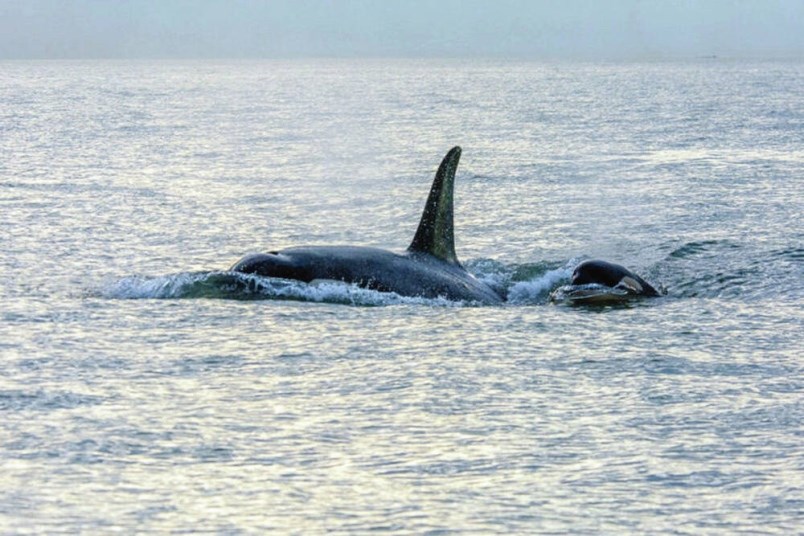The popular theory that the endangered southern resident killer whales are suffering from a lack of chinook salmon in the Salish Sea may not hold water.
Scientists at the University of British Columbia claim their research indicates there is plenty of prey — at least during the summer — in the orcas’ traditional habitat in the Juan de Fuca Strait.
A lack of chinook has been blamed for the southern residents’ declining population and low birth rates. The orcas rely almost exclusively on chinook as a food source. Only 73 of them remain, in three pods.
In a paper published in the Canadian Journal of Fisheries and Aquatic Sciences, UBC researchers say the numbers of chinook in the Salish Sea in summer are four to six times more abundant for southern resident killer whales than northern resident killer whales.
“People have been talking about a prey shortage as if it’s a fact, but this is the first study to quantify and compare the amount of their preferred prey, chinook salmon, available to southern and northern resident killer whales,” lead author Mei Sato said in a statement.
The increasing northern resident population numbers about 300. In recent years, southern residents have also been returning later than normal to the inside coastal waters of British Columbia and Washington.
Andrew Trites, professor and director of the Marine Mammal Research Unit at UBC, said measurements from drone footage have shown the southern residents are thinner on average than the northern residents, which supports the popular belief that the southern residents are experiencing a food shortage.
“Our findings suggest that this food shortage is probably not occurring during the summer when they have traditionally fed in the Salish Sea,” he said.
Researchers spent the summers of 2018 and 2019 surveying two areas known to be important foraging habitats for resident orcas — the Johnstone Strait for northern residents and the Juan de Fuca Strait for southern residents, where the orcas intercept migrating chinook returning to the Salish Sea.
Using fish finders, the UBC team compared the number and size of Chinook salmon in the two straits.
“Killer whales use a similar technique to locate the fish — only it’s much better than the electronic one we use because they can distinguish between different fish species in the water,” said Sato.
Researchers captured sample fish to validate the acoustic signals from their fish finder and distinguish between different fish species, as orcas prefer larger, older chinook.
They found that while the distribution and sizes of fish were similar in both straits, there were four to six times as many fish in patches of the Juan de Fuca Strait.
The study, however, did not assess other factors that might prevent the orcas from catching the fish, such as higher vessel presence and noise in the Juan de Fuca Strait compared with Johnstone Strait.
Boat noises can interfere with the orcas’ natural echo-location abilities used to find food.
Sato said the focus of ongoing research on the southern residents’ health should be directed to prey availability in other areas where the residents forage, and in different seasons.
“We don’t really know about prey availability outside of the Salish Sea and outside the summer season,” she said. “To answer the question of whether there’s an overall prey shortage, we still need to figure out what’s happening during winter and spring, whether there are significant fluctuations year-to-year and in the different locations these whales travel to, like California.”
The southern residents have made only a handful of visits to the Salish Sea this past summer, showing up in Georgia Strait, near the U.S. San Juan Islands and around Sooke.
Two orcas died this year and three were discovered to be pregnant.
Some observers suggest the southern residents are spending more time in the “fish lanes” further offshore, while others say they are circumnavigating the Island or heading further south for their summer feeding.
Others suggest their travel and foraging patterns have changed since the death of J2, known as Granny, in 2015. Some researchers say she was 105 at the time her death; others claim she was between 65 and 80.
Matriarchs are leaders and teachers in the pods, helping to raise the young and leading other members to foraging areas.



